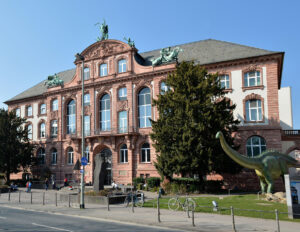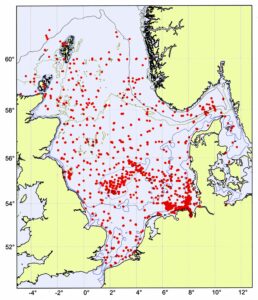Participating Museums and Institutions
Christian-Albrechts-Universität Kiel, Zoologisches Museum
The historical collections in Kiel consist of four parts, which build on each other. The earliest collections were made by Karl August Möbius, who began to collect the fauna of the Kiel Bight systematically for his comprehensive publication „Die Fauna der Kieler Bucht“. Beginning in 1871, the Kiel Commission for the Investigation of German Seas (“Kieler Kommission zur Untersuchung der deutschen Meere“) conducted systematic research cruises in North and Baltic Sea using exactly located sampling stations. Around 1900, the so-called “Terminfahrten” took place with the research vessel “Poseidon”. The “Poseidon” routinely sampled a dense network of exactly located stations (see Fig. 1 and 2). The extent of the collections can only be estimated roughly at this point, as much of the Kiel collection has not yet been recorded. The majority are mega-epibenthos samples, and the most important animal taxa are crustaceans, mollusks and echinoderms/tunicates. The Baltic Sea collection encompasses ca. 1800 samples, and the North Sea collection around 8000 samples. In addition, few much older samples were collected by Wilhelm Behn in the 1840s, as well as an unknown number of dried samples, probably predominantly mollusc shells. From the “Terminfahrten”, 30 glass jars have not yet been sorted, and contain probably another 300 to 400 samples. Figures 1 and 2 provide an overview of the sampling stations. The samples are all preserved in ethanol, and preliminary tests showed that the samples are well-suited for molecular and morphological studies.


Senckenberg Forschungsinstitut und Naturmuseum, Frankfurt


The Kiel collections are complemented by a second major collection, the benthos samples of the Senckenberg Research Institute Frankfurt (Fig. 3). It is the most comprehensive collection of North Sea fauna worldwide. For the past 45 years, scientists of Senckenberg have sampled the benthos from exactly located stations in the coastal North Sea on a monthly or quarterly basis. The longest time series has been maintained from the Jade region, which is close to the institute “Senckenberg am Meer” in Wilhelmshaven. Since 1970, coastal samples are routinely collected, and since 1974, nets are used to fish at exactly located stations. Other routine sampling takes place off Norderney and in the “Helgoländer Tiefe Rinne”, a deep sink in the North Sea, starting in 1976 and 1977, respectively. Besides these main areas, locations in the southern North Sea and in the German Bight are regularly sampled. At present, the Senckenberg collection contains faunal samples from over 4000 North Sea locations.

Museums and Institutions of the NORe Association
The two major collections are supplemented by the collections of the NORe association. These smaller collections might contain important time series or single specimens, which fill temporal or spatial gaps, thus adding to and improving our understanding of faunal changes.

List of contributing institutions
-

Übersee-Museum, Bremen
-

Centrum für Naturkunde (CeNak), Universität Hamburg
-

Zoologische Sammlung, Universität Rostock
-

Museum für Natur und Umwelt, Lübeck
-

Staatliches Naturhistorisches Museum, Braunschweig
-

Niedersächsisches Landesmuseum für Natur und Mensch, Oldenburg
-

Zoologisches Museum, Universität Greifswald
-

Müritzeum, Waren (Müritz)
-

Deutsches Meeresmuseum, Stralsund
| Deutsches Meeresmuseum, Stralsund | DMM |
| Niedersächsisches Landesmuseum für Natur und Mensch, Oldenburg | LMNM |
| Museum für Natur und Umwelt, Lübeck | MNUL |
| Müritzeum, Waren | MUW |
| Senckenberg Forschungsinstitut und Museum Frankfurt | SMF |
| Staatliches Naturhistorisches Museum, Braunschweig | SNMB |
| Senckenberg Staatliche Naturkundliche Sammlungen Dresden | SNSD |
| Übersee-Museum, Bremen | UMB |
| Zoologisches Museum der Universität Greifswald | ZIMG |
| Centrum für Naturkunde (CeNak) der Universität Hamburg | ZMH |
| Zoologisches Museum der Universität Kiel | ZMK |
| Zoologische Sammlung der Universität Rostock | ZSRO |

